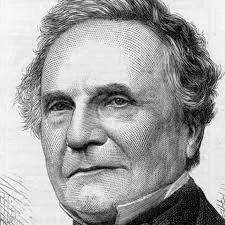A computer is an electronic machine that takes instructions, processes data, and gives results. It can do many tasks like solving problems, storing information, playing games, connecting to the internet, and even talking with humans. Today, computers are everywhere — in schools, hospitals, homes, and industries.
A Short History of Computers
The journey of computers began in the 1800s when Charles Babbage (1791-1871) , known as the Father of the Computer, designed the first mechanical computing machine called the Analytical Engine. Real electronic computers were built in the 1940s, and since then, computers have become faster, smaller, and smarter.
This journey is divided into six generations, each bringing new technologies and improvements.
1st Generation (1940–1956): Vacuum Tubes
Used vacuum tubes for processing.
Very large and slow.
Produced a lot of heat and needed much electricity.
Example: ENIAC, UNIVAC.
2nd Generation (1956–1963): Transistors
Vacuum tubes were replaced by transistors.
Smaller, faster, and more reliable.
Used in science, engineering, and government work.
Vacuum tubes were replaced by transistors.
Smaller, faster, and more reliable.
Used in science, engineering, and government work.
3rd Generation (1964–1971): Integrated Circuits (ICs)
Transistors were combined into small chips called Integrated Circuits.
Computers became more powerful and affordable.
Used in businesses, schools, and homes.
Transistors were combined into small chips called Integrated Circuits.
Computers became more powerful and affordable.
Used in businesses, schools, and homes.
4th Generation (1971–Present): Microprocessors
Computers began using microprocessors (a complete CPU on a single chip).
Gave rise to Personal Computers (PCs) and laptops.
Internet, graphical user interface (GUI), and computer networks started growing.
Computers began using microprocessors (a complete CPU on a single chip).
Gave rise to Personal Computers (PCs) and laptops.
Internet, graphical user interface (GUI), and computer networks started growing.
5th Generation (Present): Artificial Intelligence (AI)
Computers started using AI to learn and solve problems like humans.
Can understand speech, play games, and help with decision-making.
Examples: Siri, Alexa, ChatGPT, facial recognition, self-driving cars.
Computers started using AI to learn and solve problems like humans.
Can understand speech, play games, and help with decision-making.
Examples: Siri, Alexa, ChatGPT, facial recognition, self-driving cars.
6th Generation (Now and Future): Super-Intelligent Computers
We are now in the age of sixth-generation computers, which are smarter, faster, and more powerful than ever before. These computers use advanced AI, quantum computing, neural networks, and nanotechnology.
Capabilities of Sixth Generation Computers:
✅ Quantum Computing: Can solve complex problems in seconds that normal computers would take years to solve.
✅ Advanced AI and Machine Learning: Learn from experience, recognize patterns, and make smart decisions.
✅ Natural Language Understanding: Understand and speak in human languages better than ever before.
✅ Computer Vision: Can see, identify, and respond to objects — used in robots and self-driving cars.
✅ Autonomous Operation: Work by themselves without needing human help — like robots, drones, and smart devices.
✅ Brain-Computer Interfaces: Can connect with the human brain — such as Neuralink, helping disabled people control devices with their thoughts.
✅ High-Speed Data Processing: Handle huge amounts of data at incredible speeds.
✅ Energy Efficiency: Use less power due to nanotechnology and better chip designs.
✅ Emotional Intelligence: Some systems are being trained to understand and respond to human emotions.
We are now in the age of sixth-generation computers, which are smarter, faster, and more powerful than ever before. These computers use advanced AI, quantum computing, neural networks, and nanotechnology.
Capabilities of Sixth Generation Computers:
✅ Quantum Computing: Can solve complex problems in seconds that normal computers would take years to solve.
✅ Advanced AI and Machine Learning: Learn from experience, recognize patterns, and make smart decisions.
✅ Natural Language Understanding: Understand and speak in human languages better than ever before.
✅ Computer Vision: Can see, identify, and respond to objects — used in robots and self-driving cars.
✅ Autonomous Operation: Work by themselves without needing human help — like robots, drones, and smart devices.
✅ Brain-Computer Interfaces: Can connect with the human brain — such as Neuralink, helping disabled people control devices with their thoughts.
✅ High-Speed Data Processing: Handle huge amounts of data at incredible speeds.
✅ Energy Efficiency: Use less power due to nanotechnology and better chip designs.
✅ Emotional Intelligence: Some systems are being trained to understand and respond to human emotions.
Examples of Sixth Generation Technology:
Google Quantum AI
IBM Watson
Tesla self-driving cars
Neuralink
AI-based medical diagnosis systems
From large and slow machines to smart and learning devices, the development of computers has been amazing. The sixth generation is not just about speed — it is about intelligence, independence, and connection with humans. In the coming years, these computers will help solve world problems in health, education, space, environment, and more. The future of computing is here — and it's more exciting than ever!
Google Quantum AI
IBM Watson
Tesla self-driving cars
Neuralink
AI-based medical diagnosis systems
From large and slow machines to smart and learning devices, the development of computers has been amazing. The sixth generation is not just about speed — it is about intelligence, independence, and connection with humans. In the coming years, these computers will help solve world problems in health, education, space, environment, and more. The future of computing is here — and it's more exciting than ever!
